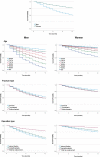Risk factors for mortality after hip fracture surgery in Japan using the National Database of Health Insurance Claims and Specific Health Checkups of Japan
- PMID: 37418095
- PMCID: PMC10329059
- DOI: 10.1007/s11657-023-01293-z
Risk factors for mortality after hip fracture surgery in Japan using the National Database of Health Insurance Claims and Specific Health Checkups of Japan
Abstract
We investigated the risk factors for mortality of hip fracture in the elderly using the National Database of Health Insurance Claims in Japan, and survival was significantly related to sex, age, fracture type, surgical procedure, delayed operative date, comorbidities, blood transfusions, and pulmonary embolism.
Purpose: Hip fracture is the most common fracture in the elderly and is known to have a high mortality rate. In Japan, to the best of our knowledge, no studies have reported on mortality risk factors for hip fracture using nationwide registry databases. This study aimed to determine the number of occurrences of hip fracture and factors that increase mortality using the National Database of Health Insurance Claims and Specific Health Checkups of Japan.
Methods: This study included extracted data from patients who were hospitalized and underwent surgical treatment for hip fracture between 2013 and 2021, using a nationwide health insurance claims database in Japan. Patient characteristics, such as sex, age, fracture type, surgical procedure, delayed operative date, comorbidities, blood transfusions, and pulmonary embolism, were tabulated to obtain 1-year and in-hospital mortality rates.
Results: Both 1-year and in-patient survival were significantly lower in men, older patients, patients who underwent surgery after 3 days of admission, and patients with trochanteric and subtrochanteric fractures, internal fixation, more preoperative comorbidities, blood transfusions, and pulmonary embolism.
Conclusions: Survival was significantly related to sex, age, fracture type, surgical procedure, delayed operative date, comorbidities, blood transfusions, and pulmonary embolism. As the number of male patients with hip fracture will increase with the aging of society, medical staff must provide sufficient information before surgery to avoid postoperative mortality.
Keywords: Health insurance claim database; Hip fracture; Mortality; National database; Risk factors.
© 2023. The Author(s).
Conflict of interest statement
None.
Figures
Similar articles
-
Medical expenditures for fragility hip fracture in Japan: a study using the nationwide health insurance claims database.Arch Osteoporos. 2022 Apr 11;17(1):61. doi: 10.1007/s11657-022-01096-8. Arch Osteoporos. 2022. PMID: 35403938 Free PMC article.
-
Insufficient increase in bone mineral density testing rates and pharmacotherapy after hip and vertebral fracture: analysis of the National Database of Health Insurance Claims and Specific Health Checkups of Japan.Arch Osteoporos. 2021 Sep 12;16(1):130. doi: 10.1007/s11657-021-00992-9. Arch Osteoporos. 2021. PMID: 34510296
-
Is Delayed Time to Surgery Associated with Increased Short-term Complications in Patients with Pathologic Hip Fractures?Clin Orthop Relat Res. 2020 Mar;478(3):607-615. doi: 10.1097/CORR.0000000000001038. Clin Orthop Relat Res. 2020. PMID: 31702689 Free PMC article.
-
Stroke Research Using Administrative Claims Database in Japan: A Narrative Review.J Atheroscler Thromb. 2024 Oct 1;31(10):1341-1352. doi: 10.5551/jat.RV22022. Epub 2024 Aug 3. J Atheroscler Thromb. 2024. PMID: 39098041 Free PMC article. Review.
-
A Review of Studies Using Japanese Nationwide Administrative Claims Databases.Ann Clin Epidemiol. 2023 Jan 28;5(2):58-64. doi: 10.37737/ace.23008. eCollection 2023. Ann Clin Epidemiol. 2023. PMID: 38505730 Free PMC article. Review.
Cited by
-
Respiratory Complications Are the Main Predictors of 1-Year Mortality in Patients with Hip Fractures: The Results from the Alzira Retrospective Cohort Study.Geriatrics (Basel). 2024 Apr 9;9(2):47. doi: 10.3390/geriatrics9020047. Geriatrics (Basel). 2024. PMID: 38667514 Free PMC article.
-
One-year mortality risk in older individuals with femoral intertrochanteric fracture: a tertiary center in China.BMC Geriatr. 2024 Jun 22;24(1):544. doi: 10.1186/s12877-024-05159-y. BMC Geriatr. 2024. PMID: 38909190 Free PMC article.
-
[Research progress of rapid surgery for hip fracture in elderly patients].Zhongguo Xiu Fu Chong Jian Wai Ke Za Zhi. 2023 Dec 15;37(12):1556-1561. doi: 10.7507/1002-1892.202308038. Zhongguo Xiu Fu Chong Jian Wai Ke Za Zhi. 2023. PMID: 38130201 Free PMC article. Review. Chinese.
-
Association between Central Nervous System Drugs and Femoral Fracture Risk in Japanese Individuals ≥80 Years Old: A Case-crossover Study.Intern Med. 2025 Jan 1;64(1):65-72. doi: 10.2169/internalmedicine.3224-23. Epub 2024 May 30. Intern Med. 2025. PMID: 38811230 Free PMC article.
References
Publication types
MeSH terms
LinkOut - more resources
Full Text Sources
Medical
Research Materials



